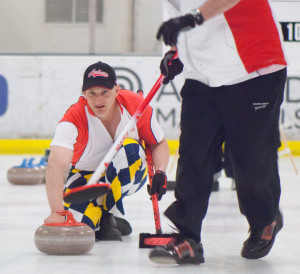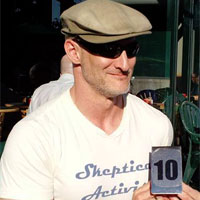By Jay Diamond
I’m a curler.
There – I said it.
 Since this is a blog about bodybuilding, you might think that I mean “curling weights”. You’d be wrong. Those who don’t know me might think it’s about curling hair. It’s DEFINITELY NOT (certainly not my hair).
Since this is a blog about bodybuilding, you might think that I mean “curling weights”. You’d be wrong. Those who don’t know me might think it’s about curling hair. It’s DEFINITELY NOT (certainly not my hair).
By curling, I mean the Olympic sport in which a 42 lb. piece of granite is hurled more than a 100’ to within an inch of its intended target.
Why am I confessing to this on a blog about skepticism in bodybuilding? It has everything to do with the power of negative thinking.
Self-help gurus flog their books about “the power of positive thinking”. What started with Norman Vincent Peale’s rather innocent, faith-based “The Power of Positive Thinking” has been pumped-up to create enormous self-help empires. Consider “The Secret”, which has sold an estimated 21 million copies in dozens of languages pushing the concept of positive thinking and that wishful thinking creates reality.
21 million people can’t be wrong, right?
You bet they can.
Students who visualize success on an exam tend to study less, resulting in lower marks (Pham 1999). Executives with over-inflated concepts of their ability often cause corporate catastrophes (Lovallo & Kahneman 2003). While you silly, fallible humans are easily swayed by uplifting anecdotes, lots of research shows that not only is this magical thinking delusional, but that it can be extremely harmful.
I’m certainly not advocating being a lethargic curmudgeon – there is some demonstrable value in optimism, but shifting a preposterous Pollyanna paradigm slightly can yield insights into our motivations. That’s the relation to fitness and bodybuilding – which is as much about motivation as hard work. Wishing yourself to be bigger/leaner/stronger won’t make it happen, but you can rather easily convince yourself that it’s just a little too much effort. It takes hard work, and that work is easily abandoned with the power of negative thinking.
Before I started working out, I believed that lean, muscular, “ripped” bodies were completely the result of genetics. Why bother working out if you don’t have lucky genes? While genetics certainly plays a role, much of fitness is simply methodical hard work. Its far easier to stay at home than head for the gym, and there’s always the excuse of work, or kids, that one last game of minesweeper… there’s always something. The power of negative thinking is about deluding yourself into not accomplishing something that is actually good for you- something you’ve decided is a priority but is trivially prioritized below other things. Negative thinking is about psyching yourself out.
And that brings me back to curling. I really enjoy the social aspects, the sportsmanship, and the physical workout. Everyone who first sees this sport on television sees brooms and immediately concludes that it involves some kind of light housekeeping. At the competitive level, its actually interval cardio – one of the best things you can do for your heart, and an exercise that leaves me exhausted after a 2-hour game. (More about interval cardio in a future blog)
In John Morris’s excellent book “Fit to Curl”, the Olympian details an intense regimen around balance, endurance, and strength specific to a sport unfamiliar to most Americans. While most curlers are recreational, you can raise this sport to whatever level you desire– all the way to Olympian-level. The best curlers do just that, with the capability of hurling rocks (that 42 lb. piece of granite) at high speeds with great accuracy, or creating enough friction on the ice with intense brushing to pull a curling stone an additional 10-15 feet.
I’m not advocating that you take up curling (actually I am, but that’s not my central thesis for this blog). I use curling as an example because you likely have something that YOU love to do… something you’ll prioritize over watch television while munching on pork-rinds. This isn’t some kind of paranormal magical thinking – it’s merely doing what you like. That’s motivation.
For many, that’s not going to the gym, and that’s OK. It might be playing racquetball, hiking, skiing… or an activity that others don’t understand – like curling. It doesn’t matter – as long as you want to do it regularly and stick to it. Something that allows you to compete against yourself by improving over time in some measure of speed, strength, or endurance.
That’s not self-help. It’s methodical self-improvement.
And that’s not magical thinking. It’s setting realistic, achievable goals.
References:
- From Thought to Action: Effects of Process-Versus Outcome-Based Mental Simulations on Performance — Lien B. Pham, Personality and Social Psychology Bulletin, 1999
- Delusions of Success: How Optimism Undermines Executives’ Decisions— Dan Lovallo and Daniel Kahneman, Harvard Business Review, 2003
- SHAM: How the Self-Help Movement Made America Helpless — Roy Baumeister, 2006
Jay Diamond is the founder of Reason4Reason – a skeptical activist group based in the San Francisco bay area. He holds dual masters degrees in engineering and business and has managed both startup companies and hundred-million-dollar programs for Fortune 50 companies. Growing up in Canada, he performed magic, studied science, and became aware of the skeptical movement. Jay has lectured around the world on science & technology, business, and skepticism.

